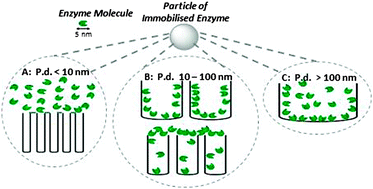Effect of pore size on the performance of immobilised enzymes†
Abstract
Porous materials are widely employed as supports in the immobilisation of enzymes. Traditionally macroporous materials with pore diameters >50 nm were believed to be the most suitable support material, ensuring no spatial restrictions upon enzyme molecules entering such large pores. In recent years however, there has been growing emphasis in the use of mesoporous supports with pore diameters ranging between 2 and 50 nm. It is thought this smaller pore range may offer enhanced conformational stability to immobilised enzymes while not being so small as to restrict enzyme access. Despite their increasing popularity, many argue that mesoporous materials have not yet proven superior to traditional macroporous supports for enzyme immobilisation. Through the design and application of a unique confidence rating system we were able to accurately compare data and establish trends between pore characteristics and protein loading. By analysing published data (182 experiments in total) and extracting pore characteristics and protein loading values, we have described three categories of pore diameters in which correlations between pore characteristics and protein loading are noted. With pore diameters less than 10 nm we see a general decrease in protein loading as the enzymes find physical restrictions in accessing the high surface offered in this pore diameter range. At pore sizes greater than 100 nm, protein loading generally decreases due to a concomitant reduction in available surface area. In the pore range of 10–100 nm there it is expected to see a decrease in protein loading level with increasing pore diameter. In fact protein loading in this range remains largely constant, suggesting some degree of protein–protein interaction blocking pores and restricting access to the increasing surface area available at decreasing pore diameters. No trends were established between pore characteristics and retention of activity.

- This article is part of the themed collection: Enzyme immobilisation

 Please wait while we load your content...
Please wait while we load your content...